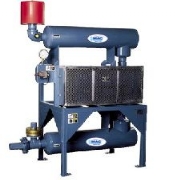 Add My Company
Add My Company
Sign In

Dilute phase pneumatic conveying systems, also know as suspension flow, operate on the principle that the solids will be suspended in the conveying line air stream. This is accomplished by metering product into a moving air stream. Dilute phase conveying velocities typically are greater than 3500 FPM and material to air ratios are less than 12 to 1. Individual particles in the air stream will have some separation by their suspension in the air stream.
Pressure, vacuum, combination vacuum/pressure and vacuum sequencing are the common types of dilute phase systems. The motive gas is typically generated by a positive displacement blower with pressure capability ranging from 2 - 15 PSIG. Pressure systems generally use a rotary airlock as a feed device. A vacuum system simply needs a product flow control device such as a probe box or screw feeder, although rotary airlocks are commonly used.
For more information on Dilute Phase Vacuum and Pressure Systems talk to Clyde Process
Enquire Now
List your company on FindTheNeedle.
